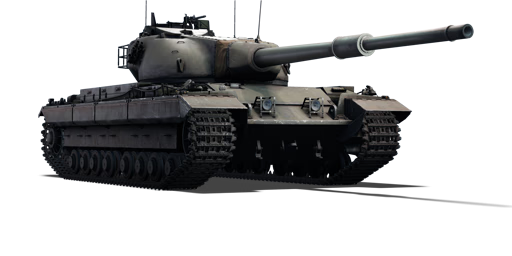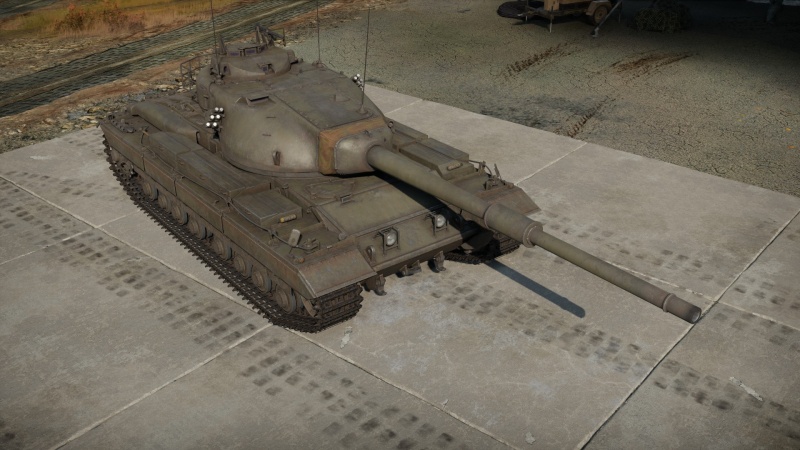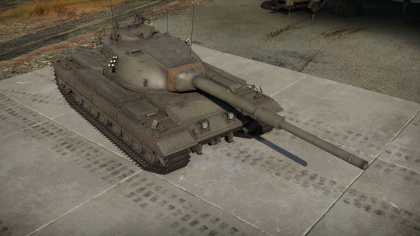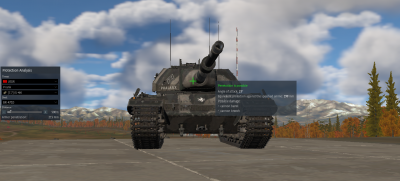Difference between revisions of "Conqueror"
FantePhala (talk | contribs) m (→Usage in battles: removed laser ranger disinformation) (Tag: Visual edit) |
|||
| Line 1: | Line 1: | ||
| − | {{Specs-Card|code=uk_conqueror_mk_2}} | + | {{Specs-Card |
| + | |code=uk_conqueror_mk_2 | ||
| + | |images={{Specs-Card-Image|GarageImage_{{PAGENAME}}.jpg}} | ||
| + | }} | ||
== Description == | == Description == | ||
| Line 13: | Line 16: | ||
== General info == | == General info == | ||
=== Survivability and armour === | === Survivability and armour === | ||
| + | {{Specs-Tank-Armour}} | ||
<!-- ''Describe armour protection. Note the most well protected and key weak areas. Appreciate the layout of modules as well as the number and location of crew members. Is the level of armour protection sufficient, is the placement of modules helpful for survival in combat? If necessary use a visual template to indicate the most secure and weak zones of the armour.'' --> | <!-- ''Describe armour protection. Note the most well protected and key weak areas. Appreciate the layout of modules as well as the number and location of crew members. Is the level of armour protection sufficient, is the placement of modules helpful for survival in combat? If necessary use a visual template to indicate the most secure and weak zones of the armour.'' --> | ||
[[File:Conqueror trapshot mantlet .png|thumb|400x400px|A basic weak spot of the Conqueror; the gun mantlet. The area is hit because of Conqueror's poor depression. It can be targeted by large-calibre HE, APDS and Sabot shells. -''The shown camouflage is known as 'Phalanx', part of the 'Night vision' trophy.'']] | [[File:Conqueror trapshot mantlet .png|thumb|400x400px|A basic weak spot of the Conqueror; the gun mantlet. The area is hit because of Conqueror's poor depression. It can be targeted by large-calibre HE, APDS and Sabot shells. -''The shown camouflage is known as 'Phalanx', part of the 'Night vision' trophy.'']] | ||
| Line 48: | Line 52: | ||
=== Mobility === | === Mobility === | ||
| + | {{Specs-Tank-Mobility}} | ||
<!-- ''Write about the mobility of the ground vehicle. Estimate the specific power and manoeuvrability, as well as the maximum speed forwards and backwards.'' --> | <!-- ''Write about the mobility of the ground vehicle. Estimate the specific power and manoeuvrability, as well as the maximum speed forwards and backwards.'' --> | ||
| Line 55: | Line 60: | ||
When the add-on armour package is researched and equipped, the vehicle's weight will increase by 1.1 tonnes, resulting in a minor decrease in mobility. | When the add-on armour package is researched and equipped, the vehicle's weight will increase by 1.1 tonnes, resulting in a minor decrease in mobility. | ||
| + | |||
| + | === Modifications and economy === | ||
| + | {{Specs-Economy}} | ||
== Armaments == | == Armaments == | ||
| + | {{Specs-Tank-Armaments}} | ||
=== Main armament === | === Main armament === | ||
| + | {{Specs-Tank-Weapon|1}} | ||
<!-- ''Give the reader information about the characteristics of the main gun. Assess its effectiveness in a battle based on the reloading speed, ballistics and the power of shells. Do not forget about the flexibility of the fire, that is how quickly the cannon can be aimed at the target, open fire on it and aim at another enemy. Add a link to the main article on the gun: <code><nowiki>{{main|Name of the weapon}}</nowiki></code>. Describe in general terms the ammunition available for the main gun. Give advice on how to use them and how to fill the ammunition storage.'' --> | <!-- ''Give the reader information about the characteristics of the main gun. Assess its effectiveness in a battle based on the reloading speed, ballistics and the power of shells. Do not forget about the flexibility of the fire, that is how quickly the cannon can be aimed at the target, open fire on it and aim at another enemy. Add a link to the main article on the gun: <code><nowiki>{{main|Name of the weapon}}</nowiki></code>. Describe in general terms the ammunition available for the main gun. Give advice on how to use them and how to fill the ammunition storage.'' --> | ||
{{main|Ordnance QF Tk. L1A2 (120 mm)}} | {{main|Ordnance QF Tk. L1A2 (120 mm)}} | ||
| Line 137: | Line 147: | ||
=== Machine guns === | === Machine guns === | ||
| + | {{Specs-Tank-Weapon|2}} | ||
| + | {{Specs-Tank-Weapon|3}} | ||
<!-- ''Offensive and anti-aircraft machine guns not only allow you to fight some aircraft but also are effective against lightly armoured vehicles. Evaluate machine guns and give recommendations on its use.'' --> | <!-- ''Offensive and anti-aircraft machine guns not only allow you to fight some aircraft but also are effective against lightly armoured vehicles. Evaluate machine guns and give recommendations on its use.'' --> | ||
{{main|L3A1 (7.62 mm)}} | {{main|L3A1 (7.62 mm)}} | ||
Revision as of 09:25, 28 December 2020
Contents
Description
The Tank Heavy Gun Conqueror Mk 2 is a rank V British heavy tank
with a battle rating of 7.7 (AB/RB/SB). It was introduced in Update 1.55 "Royal Armour" along with the initial British ground tree. Designed to combat the Soviet IS-3, the Conqueror gives the British line a much-needed vehicle with an emphasis on armour and firepower, with a 120 mm L1A2 cannon capable of defeating all of the Rank V competition it will face.
The Conqueror was the tank the Caernarvon hull was designed for - the Caernarvon itself only being a stop-gap measure, with most models being upgraded to Conquerors once the type was approved for production. The Conqueror augments this hull with a significantly upgraded turret design housing the L1A2 120mm cannon.
The Conqueror deviates from most earlier British designs, favouring firepower and armour. This, combined with its somewhat limited mobility, results in the Conqueror proving to be one of, if not the single most effective sniper and support tank at its rank. Despite this, it can be put to good use in close-range engagements.
General info
Survivability and armour
The Conqueror utilises the same hull as the Caernarvon does, with respectable frontal armour capable of shrugging off rounds from many adversaries. Unfortunately, this hull suffers from similarly weak side and rear armour - and as such angling, the vehicle can prove extremely dangerous if it exposes the side too much. The Conqueror replaces the Caernarvon's Centurion-based turret with a fresh design, providing much better crew spacing and protection. The turret is not without its weaknesses, however; the commander's cupola protrudes quite significantly and APHE or HESH shells may disable internal turret components or crew members. There is also a weak section directly behind the mantlet at the top of the turret, penetration of which will disable crew or the breech/horizontal turret drive. Trap shots are possible, it is likely to get shot with a high calibre HE, capable of damaging the tank by hitting the base of the turret and exploding into the driver and/or ammo rack just below it. Unlike with similar tank M103 though, for most heavy tanks HE can only penetrate the driver hatch, taking them out, and damage the gun breech on a good hit. SPG calibre HE (like 152 mm of Object 268) will definitely destroy the roof armour and ammo rack, resulting in a one-shot, unless only a few shells are being carried (which is highly impractical). Non-HE shells are less likely to ricochet and do significant internal damage like this, but it is still possible to push them into the tank.
The frontal track guards are also very vulnerable at particular angles and can be exploited even when sides are not exposed to instantly destroy the tank using nearly any gun, like with Churchill Mk VII. The more realistic scenario, however, is high calibre HESH hitting the ground next to them and setting the tank on fire or outright destroying it. Fortunately, most tanks which are capable of this and are going out of their way to use HESH instead of HEAT are British and can only be your opponent in AB, in RB the likelihood of receiving such hit is greatly reduced.
The Conqueror has a researchable add-on armour package which improves the vehicle's survivability to HEAT rounds and by a small amount to kinetic rounds.[1]
Armour type:
- Rolled homogeneous armour
- Cast homogeneous armour (Turret)
- Structural steel (Side skirts)
| Armour | Front | Sides | Rear | Roof |
|---|---|---|---|---|
| Hull | 130 + 20 mm (59°) Front glacis 76 mm (44°) Lower glacis |
51 + 6 mm | 38 mm Top 20 mm (60°) Bottom |
44 mm Front 17 mm Crew hatch 17 mm Rear |
| Turret | 152-313 mm (0-68°) Turret front 89-200 mm (0-78°) Gun mantlet |
89-233 mm (1-48°) | 50 mm (1-34°) | 51 mm 31 mm Square area near gun 17 mm Crew hatches |
| Armour | Front | Rear | Roof | |
| Cupola | 203 mm (0-17°) | 70 mm (12-14°) | 51 mm 17 mm Crew hatch |
Notes:
- Suspension wheels and bogies are 20 mm thick while tracks are 30 mm thick.
- Front of turret vary in armour thickness, from 152 mm to 313 mm, but it is all very sloped due to turret design.
- The front of the turret roof has an additional armour plate of 31 mm in thickness.
Mobility
| Game Mode | Max Speed (km/h) | Weight (tons) | Engine power (horsepower) | Power-to-weight ratio (hp/ton) | ||||
|---|---|---|---|---|---|---|---|---|
| Forward | Reverse | Stock | AoA | Stock | Upgraded | Stock | Upgraded | |
| Arcade | 37 | 13 | 64.9 | 1.1 | 1,046 | 1,545 | 16.12 | 23.41 |
| Realistic | 35 | 12 | 716 | 810 | 11.03 | 12.27 | ||
The Conqueror has reasonable mobility, despite its weight, thanks to a powerful engine and favourable gearbox ratios. It does suffer from a somewhat limited top speed of 34 km/h, however it reaches this speed fairly easily on-road and on smooth off-road surfaces. The vehicle has surprisingly responsive hull traverse due to the engine power and neutral steering capability. The Conqueror has a reasonable reverse speed for a British vehicle, however it shouldn't be relied on too heavily.
When the add-on armour package is researched and equipped, the vehicle's weight will increase by 1.1 tonnes, resulting in a minor decrease in mobility.
Modifications and economy
Armaments
Main armament
The 120 mm L1A2 is a powerful gun, derived from the M58 mounted on the M103 heavy tank. Unlike the M103's selection of HEAT or AP, the Conqueror instead utilises HESH and APDS ammunition, and again unlike the M103, mounts a two-plane stabiliser. The L1A2 exhibits excellent accuracy and long-range performance, although due to the sub-par post-penetration effects of APDS in some cases multiple rounds are required to secure a knock-out, particularly at range where critical components or ammunition is less reliably hit.
Despite this, the Conqueror performs admirably as a sniper, covering capture points or thoroughfares, and should primarily rely on APDS with careful thought as to placement. HESH may prove useful against lighter vehicles or in cases where a target's side armour is exposed, but otherwise should not be relied on for anything besides pure luck. It's important to remember that the Conqueror has a reasonably long reload of 19.4 seconds at base; and as such careful consideration should be made as to what to prioritise disabling first.
| 120 mm Ordnance QF Tk. L1A2 | Turret rotation speed (°/s) | Reloading rate (seconds) | |||||||||||
|---|---|---|---|---|---|---|---|---|---|---|---|---|---|
| Mode | Capacity | Vertical | Horizontal | Stabilizer | Stock | Upgraded | Full | Expert | Aced | Stock | Full | Expert | Aced |
| Arcade | 35 | -7°/+15° | ±180° | Two-plane | 13.2 | 18.3 | 22.2 | 24.5 | 26.1 | 19.37 | 17.14 | 15.80 | 14.90 |
| Realistic | 9.7 | 11.4 | 13.9 | 15.3 | 16.3 | ||||||||
Ammunition
| Penetration statistics | |||||||
|---|---|---|---|---|---|---|---|
| Ammunition | Type of warhead |
Penetration @ 0° Angle of Attack (mm) | |||||
| 10 m | 100 m | 500 m | 1,000 m | 1,500 m | 2,000 m | ||
| Shot L1G | APDS | 362 | 361 | 359 | 354 | 339 | 321 |
| Shell L1TK | HESH | 152 | 152 | 152 | 152 | 152 | 152 |
| Shell details | |||||||||
|---|---|---|---|---|---|---|---|---|---|
| Ammunition | Type of warhead |
Velocity (m/s) |
Projectile Mass (kg) |
Fuse delay (m) |
Fuse sensitivity (mm) |
Explosive Mass (TNT equivalent) (g) |
Ricochet | ||
| 0% | 50% | 100% | |||||||
| Shot L1G | APDS | 1,493 | 7.6 | N/A | N/A | N/A | 75° | 78° | 80° |
| Shell L1TK | HESH | 792 | 15.87 | 0.05 | 0.1 | 3,970 | 73° | 77° | 80° |
Ammo racks
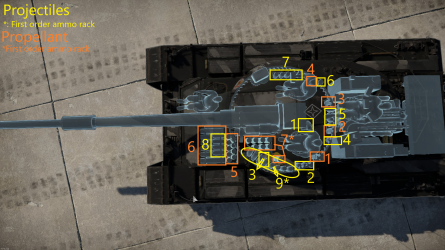
| Full ammo |
1st rack empty |
2nd rack empty |
3rd rack empty |
4th rack empty |
5th rack empty |
6th rack empty |
Visual discrepancy |
|---|---|---|---|---|---|---|---|
| 35 | 31 (+4) | 21 (+14) | 16 (+19) | 11 (+24) | 6 (+29) | 1 (+34) | No |
Keep ammo at around 16 (+19) or 11 (+24)
Machine guns
The Conqueror sports two machine guns, one of which is pintle mounted and may prove itself a deterrent to some close air support. The machine guns may on occasion prove useful for destroying incoming ATGMs, given a bit of luck.
| 7.62 mm L3A1 | ||||
|---|---|---|---|---|
| Mount | Capacity (Belt) | Fire rate | Vertical | Horizontal |
| Coaxial | 3,750 (250) | 500 | N/A | N/A |
| Pintle | 3,750 (250) | 500 | -10°/+30° | ±90° |
Usage in battles
The Conqueror can be effectively played as a sniper, or a steady breakthrough tank, providing the vehicle's slow reload and weak lower front plate are considered. This heavy tank should not be played in a brawling role. It will easily be flanked and disposed by the side armour plates. Commanders are advised to remain on some of these roles:
Sniper Role
When used in a sniper role, the Conqueror should utilise extreme ranges with some form of cover available, in case the situation goes awry. Ensure awareness is maintained for light flanking vehicles or enemy sniping vehicles on off-angles that may be able to disable the Conqueror through side armour. Play conservatively, avoiding wasting shots, having to wait for the long reload time, and avoid exposing the hull where possible.
Remember the rangefinder and if possible find locations that cover the hull of the Conqueror.
Breakthrough Role
The Conqueror may be utilised in a breakthrough role, although it should be played conservatively with allies and with a level of map awareness at all times. The stabilised gun allows the conqueror to comfortably fire on the move - a rare piece of equipment at the rank - this gives it a distinct advantage over most targets it will face at close range, with the ability to reliably hit targets without waiting for the suspension sway to subside. However, the vehicle's slow reload means that calculated shots are a requirement, and wasting any round may have dire results.
As usual, keep in mind that the vehicle's sides and lower front plate are particularly vulnerable and exposing either to enemy fire will often result in the Conqueror's destruction. If the advance seems to be failing, or the Conqueror is on risk to be flanked. Remember the good reverse speed, this along smoke cover will grant second chances.
Modules
| Tier | Mobility | Protection | Firepower | ||
|---|---|---|---|---|---|
| I | Tracks | Parts | Horizontal Drive | ||
| II | Suspension | Brake System | FPE | Adjustment of Fire | |
| III | Filters | Crew Replenishment | Elevation Mechanism | Smoke grenade | |
| IV | Transmission | Engine | Additional Ballistic Protection Package | Rangefinder | |
Pros and cons
Pros:
- APDS round is extremely powerful and accurate, with a maximum of 362 mm of penetration at 10m/0°
- HESH ammo may have surprising results, and can prove particularly effective against light or side armour
- The L1A2 cannon is fully two-plane stabilised, allowing it to be fired accurately on the move
- Coaxial machine gun has ballistic performance similar to the HESH round and may be used for ranging
- Turret and upper front plate are very sloped and armoured, with very few weak points
- Add-on armour offers more protection in the form of spaced armour to the turret cheeks and upper plate
- Well-spaced crew make the vehicle unlikely to be affected by crew knock-out in a single hit
- Reasonably good mobility despite weight and huge gun
- Rangefinder allows for accurate distance measuring up to 1,300 m.
Cons:
- HESH is not reliable against any vehicle with semi-decent armour; requires high skills and knowledge of the enemy
- Long reload time (19.4 second base) for British standards, although relatively standard for calibre
- Only 7.62 mm machine guns
- Particularly weak side armour and lower front plate; will be commonly targeted areas.
- Only 17 mm of protection on the wide engine deck will be targeted by planes
- Top speed is limited at only 34 km/h; it faces really mobile enemies such as the Leopards
- Penetrations in the turret ring area often results in ammunition detonation; ammo racks are strewn all-around
- Outstandingly high repair cost, nearing 20,000 SL in RB and SB
History
Development
In 1944, General Staff started a project called A45 Infantry Support Tank, which started around the same time as the development of the A41 Centurion cruiser tank. This project, after the war, was redesignated from a typical "Infantry Tank" and instead focused on a new role of a "Universal Tank" design in the form of the FV 200 series. The "Universal Tank" concept was to design a vehicle that would have a mobility comparable to that of cruiser tanks, but with the armour and firepower of heavy tanks. The FV 200 series designation was adopted and was to serve as a line of vehicles that used the same hull and chassis in different roles like armour recovery vehicles and self-propelled guns. The first tank of this series was to be the FV 201, which would be 55 tons and use the 20-pounder gun.
In 1949, a new requirement for the project called for the use of a 120 mm gun, possibly in response to the reveal of the Soviet IS-3 heavy tank in the Berlin Victory Parade in 1945. This new requirement would delay the initial deadlines for the tank as no gun of that caliber had been developed yet. As a interim development before such a gun could be made, the FV 201 hull was mounted with a turret from the Centurion tank and this created the FV 221 Caernarvon, with Mark I for a 17-pounder armament and a Mark II for a 20-pounder armament. However, the success of the lighter Centurion tank made the Caernarvon unsuitable in a "Main Battle Tank" role. Further development on the Caernarvon, with emphasis on the armour and armament, would develop the FV 214 Conqueror tanks, some were straight up conversions of Caernarvon Mark II's. About 185 Conquerors were produced in Mk.1 and Mk.2 variants from 1955 to 1959.
Design
The FV 214 Conqueror, also known as the "Tank, Heavy No. 1, 120 mm Gun, Conqueror", was intended to provide a mobile, long-range anti-tank support for the lighter and more numerous Centurion tanks stationed in Germany. As a response to the heavy IS-3 tank in Soviet service, the tank's armament and armour is taken up and beyond extreme to typical NATO armour development. The armour, with a frontal plate of about seven inches (178 mm), made the tank one of the most protected tanks stationed in West Germany. The abundance of armour made the tank heavy, weighing 64 tons, and this impeded the tank's top speed and made it mechanically unreliable. However, the tank was very mobile in cross-country terrain, seen as equal as the lighter and faster Centurion tank.
The gun was the very large 120 mm cannon, the largest caliber tank gun available when it was introduced. The gun was American-developed, the same 120 mm cannon that would arm the M103 heavy tank. The gun uses a two-piece ammunition and the tank allowed for a ammo stowage of 35 rounds. Another notable feature of the Conqueror aside from its large cannon and thick armour was the unique and rotatable commander's cupola. In the cupola was the Conqueror's fire control system and had many features that made it ahead of its time. Being able to be rotated independent from the turret, plus with a coincidence rangefinder, the commander could align the cupola to a target, measure its range, and direct the gunner to the designated target. While the gunner located and engage the target, the commander could go and find a different target to designate and range.
Usage
The Conqueror were all stationed in West German in the armoured regiments stationed there. Each regiment received 9 Conquerors and were organized in groups of three as tank troops to support the Centurions in any conflict that arise from the tense situation of the Cold War. As history played out, the Cold War never became "hot" and no hostile conflicts arise in the borders of Germany, thus the Conquerors never saw any use aside from training as they were all exclusively stationed on the German borders. The Conqueror's intention to provide a long-range anti-tank capability for the Centurions, became less significant when the Centurions began to arm themselves with the more powerful 105 mm L7 gun, such as the Centurion Mk 10. The lower tactical value of the Conqueror and further development on heavy tanks in Britain had the Conquerors replaced in 1966 with the much more powerful and armoured, yet lighter, FV 4201 Chieftain tank.
Media
- Skins
- Videos
See also
Analogues of other nations
Related Development
Shared operational history
Succeeded by
External links
References
| Britain heavy tanks | |
|---|---|
| Matilda | Matilda III · Matilda Hedgehog |
| Churchill | Churchill I · Churchill III · Churchill VII · Churchill Crocodile · Churchill NA75 · Black Prince |
| Post-war | Caernarvon · Conqueror |
| Other | Independent · Excelsior · TOG II |


